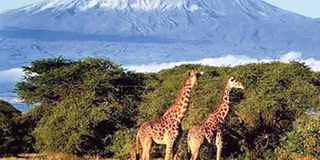Mt Kili ice loss puzzle deepens

What you need to know:
The aircraft headed straight to Mt Kilimanjaro instead of the usual route on the space between the snow-capped Africa’s roof top on the left side and the adjacent Mt Meru to right.
Arusha. Some passengers aboard the PrecisionAir flight from Nairobi to the Kilimanjaro International Airport (KIA) on April 2nd this year may have thought the pilot had lost direction.
The aircraft headed straight to Mt Kilimanjaro instead of the usual route on the space between the snow-capped Africa’s roof top on the left side and the adjacent Mt Meru to right.
Still the ATR version plane came closer to the mountain as if there was an airstrip on its less vegetated northwest corner. The ordinary passengers could not notice what the pilot was aiming at.
Finally, the mighty Kilimanjaro is here and he took a left turn. It was a clear day and many on board realised what the pilot intended to do, especially for the tourists from abroad.
He wanted them to have a clear view of the mountain which attracts over 60,000 mountain climbers a year. Some may think has defied the laws of nature due to its permanent cover of ice despite being close to the Equator.
From the northern side he commandeered the plane to the east, almost looking down the Mawenzi peak, then to the southern side which is rich in vegetation being on the wind-ward side.
Here was a total glimpse of Mt Kilimanjaro but more specifically the summit which appeared more a rugged terrain now that the ice cover has receded.
Those with cameras and smartphones were busy taking pictures despite continuous air bumps due to strong winds blowing from the east and south east.
If the passengers thought the nightmares in the air were enough and that they were on the descent to KIA, they were wrong.
The pilot circled over the mountain once again, this time coming much closer. At some point the peak appeared to be within the arm’s reach. There was anxiety for some first time ‘riders’ on the route.
A glimpse of Kilimanjaro from the air is not much different from the images on documentaries and TVs; the ice sheet which once covered its entire peak has receded considerably.
The thinning and diminishing ice cap has exposed the dissected massive cliffs on the Kibo peak which rises 5,895 metres above sea level, the highest point in Africa.
According to the experts, in the 1880s (nearly 140 years ago), the entire summit was completely covered by an ice cap measuring 20 square kilometres, with outlet glaciers cascading down the western and southern slopes.
This was the ice sheet which stunned the European explorers who visited Africa in the 18th and 19th centuries, sending texts home on the amazing find of snow cover near the Equator.
In some unclear circumstances, the slope glaciers retreated rapidly between 1912 and 1953 in what some experts attribute to sudden shift in climate. The ice coverage has dropped to 2.5 square kilometres in 2003 from about 20 km square in 1880s.
Equally receding are glaciers on the crater plateau. But geomorphological experts say they have disappeared repeatedly over the last few hundred years although no clear warming trend had been noticed during the period. Dr Ami Snorrason, the chair of the Global Cryosphere Watch, a programme of the World Metereological Organisation (WMO), does not believe the effects of climate change alone were responsible for the receding glaciers.
“It is an extremely complicated case to pinpoint the reasons for the diminishing ice. It could be an interplay between moisture, air circulation and temperatures,” he said in Arusha this week during a meeting of metereological experts.
He insisted that there was no one reason for the cause of receding glaciers from Africa’s rooftop, calling for more research. He added that the effects of climate change should not be seen as conclusive.
Dr Snorrason, who is a member of WMO-associated panel of experts on polar and high-mountain observations and research, said similar melting of ice had been recorded in Greenland and other parts of the world. The Tanzania Meteorological Agency (TMA) director general, Dr Agnes Kijazi, echoed, saying although the disappearing glaciers atop Mt Kilimanjaro has alarmed scientific experts, its reasons could be a combination of factors.
“It is linked to a complex combination of changes in air temperature, air humidity, precipitation, cloudiness and incoming solar radiation as well as diversity in weather and climate patterns,” she said.
According to her, studies indicate that the glacier surface area on the mountain was estimated to be only 2.51 square kilometres in 2003 compared to about 20 square kilometres in 1880s.
“It is likely that recent cover may be even less,” she told the meeting dubbed ‘Global Cryosphere Watch-Tropical Cryospehere Workshop at the Arusha International Conference Centre.
Dr Kijazi said despite the observed climate patterns around Mt Kilimanjaro,“very little has been done regarding weather observation and monitoring, especially at the upper part of the mountain”.
She attributed the conflicting phenomena on the receding glaciers to lack of information and data emanating from inadequate observation and limited understanding about the potential impacts of climate change on high mountains and associated ecosystems.
“Experts will have to come up with recommendations that will contribute to the development of a coordinated strategy to enhance observation and monitoring of weather and climate patterns around mountains such as Kilimanjaro,” she said.
This, according to her, will lead to formulation and implementation of research agenda towards improving the understanding of the impacts of climate change on tropical cryospheres and associated ecosystems.
Arusha regional commissioner Mrisho Gambo said the government could not pinpoint the reasons which led to the diminishing glaciers on Mt Kilimanjaro although he said it could be linked to the changing weather patterns.
“We don’t know the reasons why ice is disappearing. What should be done is to ensure the mountain is well protected for its rich ecosystem which has contributed enormously to our socio-economic well being”, he said.
According to the 4th Assessment Report of Intergovernmental Panel on Climate Change (IPCC) issued five years ago. Mt Kilimanjaro glaciers and snow cover have been retreating, with 55 per cent of glacier loss recorded between 1962 and 2000.




